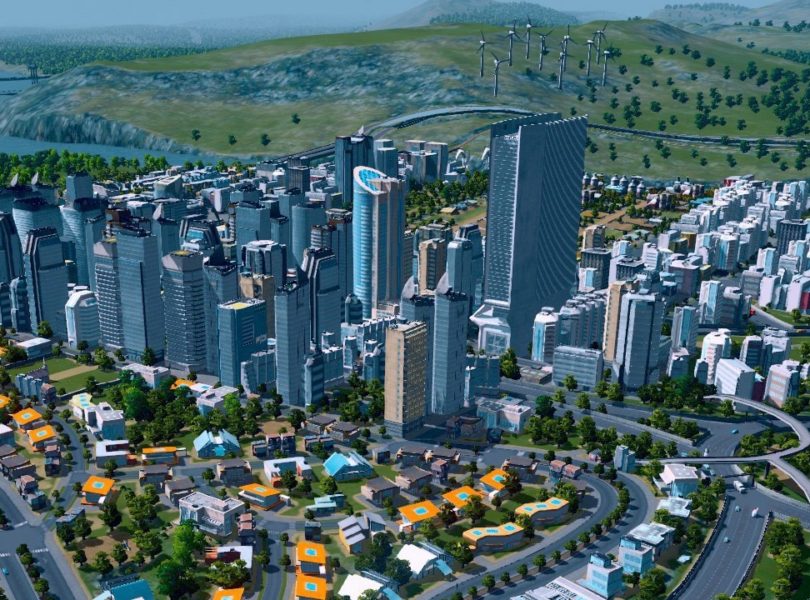The Very Definition of Digital Crack
I purposely avoid games like Cities Skylines. It’s not because I dislike them; I LOVE city planner games. It’s just that family gets really worried when they can’t get a hold of me.
Sim games make me lose long tracts of time. As proof, I am writing this sentence at 4:19 AM on a Monday. I spent my Sunday building my city. ALL of Sunday. Yes, I had to use the bathroom and eat, but those were literally the only two things I did that didn’t involve setting up my city and marveling at the city I built. I’m sure my friends and family missed me.
Cities Skylines is a spiritual successor to SimCity. In many ways, it is what the most recent SimCity should’ve been. It is a pure city building simulator that gives you the power to design the city of your dreams. The only goal is to make a city that you feel proud of. It is an overly simple concept, yet doing it can be incredibly addictive.
The usual concepts of the SimCity apply here. You do not directly make all the buildings in your city. Instead, you build roads and create zones. The zones can fall under three categories: residential, commercial, and industrial. The zones are pretty self-explanatory. They also have a symmetry between them. Residents in residential zones need commercial zones to acquire the things they need to subsist. Commercial areas require goods made from industrial zones. Both commercial and residential zones supply industrial areas with employees. Managing the needs of the three zones is a delicate balancing act.
Cities Skylines expands on the three-zone concept. Each zone has three levels: low, medium, and high. That gives players more freedom as to what kind of zones they want in their city. Maybe you want to create a suburb with the smaller houses a low-level residential zone offers. You may want to add mom ‘n pop commercial zones in this suburb. Perhaps you want a metropolis with high-rise condominiums and sprawling commercial areas. Cities Skylines has you covered.
The normal pratfalls that impede the creation of a metropolis apply. People in your city will die, so building mortuaries and crematoriums are necessary. So is building fire departments to handle fires in the city. The city also needs police stations to curb crime. Residents of your city get sick, so having nearby hospitals prevents unnecessary deaths. Your citizens need to be educated, so elementary schools, high schools, and universities are appreciated.
The most basic needs of citizens need to be accounted for as well. In addition to easy road access to essential areas, they need electricity, water, and waste service. Building power plants and water systems require some advance planning. The citizens of your city also appreciate diversions, so building parks and attractions add to their leisure options.
The available attractions are important as more than areas for recreation. Building certain attractions unlock monuments, which are buildings that enhance certain aspects of your city. For example, the Fusion Power Plant allows you to power your city efficiently, obviating the needs for multiple plants in it. Unlocking it requires building five other structures, including a tax office and a modern art museum.
All of these combine to make a game that people like me find incredibly addictive. I can find myself planning my city’s mass transit system and emerge 7 hours later, wondering why it’s so dark outside. These games are designed to be completely immersive, and Cities Skylines is perfectly designed in this regard. The urge to build one more section of a city eggs players on.
Unlike the most recent SimCity, this game is MASSIVE! You can have up to 25 map plots available for you to plop city structures in. Each of these sections is much bigger than SimCity’s rather anemic plots. Once all 25 plots are unlocked in Cities Skylines, your city becomes a sprawling mass. Filling all that up with houses, stores, factories, parks, airports, and dozens of other structures eats up loads of time from dedicated players.
This game is well supported by its developer, Colossal Order. There are numerous expansion packs available for the game. The biggest one, Natural Disasters, adds the possibility of catastrophe slamming your city. It includes the ability to plan early-warning systems and handling citizens who have been displaced. The Relaxation Station add-on only adds new music to the game, but it gives players something to listen to other than the default game soundtrack.
Better yet, Steam Workshop access gives players a way to add more structures, roadways, maps, and interface tweaks to Cities Skylines. This game is very moddable, allowing for even more options. Maybe you want to zoom down to ground level to see your city in action. Maybe you want to make your city more European, including signature European landmarks. Or maybe you just want to start the game with all 25 plots unlocked. Steam Workshop enables all of these things.
The end result is a game that invades my consciousness at all times. Sometimes I sleep thinking about additions to my city. Whenever I start the game up, I foolishly tell myself that I’m only gonna play “for a little bit.” Twenty hours after that foolish statement, I’m trying to force myself to turn off the game and go to bed.
My only saving grace is that I stopped playing Stardew Valley and Civilization VI long ago. If I were to try to set aside time for those games and Cities Skylines, I would never see real people again. Sim games are designed to be engrossing, but THIS game is the gaming equivalent to crack!


